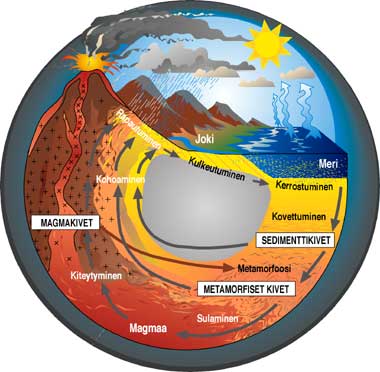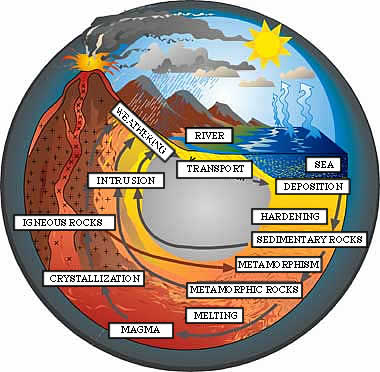
Kivikotkat
Sapokan vesipuistoa vartioivat vesiputouskallion huipulle laskeutuneet Kivikotkat. Kivihahmot on työstetty suomalaisesta kivestä ja ne esittelevät erilaisten rakennuskivinä käytettävien luonnonkivilaatujen väri- ja rakenne-eroja. Niihin on käytetty yli 30 eri kivilajia, jotka ovat peräisin yli 20 eri paikkakunnalta Suomesta.
Aineen suuri kiertokulku
Maapallo voi tuntua meistä varsin muuttumattomalta ja pysyvältä. Kuitenkin luonnon jatkuvat geologiset prosessit synnyttävät uutta kallioperää ja vuoristoja sekä rapauttavat ja kuluttavat niitä toisaalla. Oheisessa kuvassa esitetään aineen suuren kiertokulun vaiheita. Sula magma kiteytyy kiinteäksi kallioperäksi ja vuoristoiksi, joiden syntyyn vaikuttaa myös mannerlaattojen liikkeet ja törmäykset. Veden ja ilmakehän ilmiöt ja painovoima rapauttavat ja tasoittavat kallioperää. Hiekaksi ja saveksi muuttuneet kivilajit kulkeutuvat veden ja tuulen mukana meriin, jossa sedimentit kerrostuvat ja kovettuvat sedimenttikiviksi. Maankuoren liikkeiden seurauksena sedimenttikivet lopulta painuvat alas maankuoreen ja sulavat muodostaen magmaa. Aineen kiertokulun yksi kierros kestää satoja miljoonia vuosia ja kaikki siihen liittyvät prosessit ovat toiminnassa koko ajan. (lähde: finstone.fi)

Aineen suuri kiertokulku (lähde: finstone.fi)
Kivilajit
Suomen kallioperä kuuluu pääosin maapallon vanhimpiin peruskallioalueisiin. Maankuori muodostuu erilaisista kivilajeista ja Suomessa kivien ikä vaihtelee n. 1 500 miljoonasta vuodesta yli 3 000 miljoonaan vuoteen. Syntymätapansa perusteella kivilajit jaetaan kolmeen pääryhmään:
1. Magmakivilajit, joita ovat syväkivet, pintakivet ja puolipinnalliset eli juonikivilajit. Magmakivet syntyvät maanpinnan alapuolisesta kivisulasta eli magmasta. Jos magma jähmettyy syvällä maankuoren sisällä, syntyy syväkivilajeja. Tulivuorenpurkauksissa maan pinnalle ryöppyävästä magmasta syntyviä kivilajeja sanotaan vulkaanisiksi pintakivilajeiksi. Tyypillisiä syväkiviä ovat esimerkiksi graniitti, dioriitti, gabro ja peridotiitti. Koostumukseltaan niitä vastaavia pintakiviä ovat ryoliitti ja basaltti.
2. Sedimenttikivet eli kerrostuneet kivilajit. Aikojen kuluessa kivilajit rapautuvat maan pinnalla ja muuttuvat irtonaiseksi aineeksi. Rapautumistuotteet voivat kulkeutua, lajittua ja lopulta kerrostua eli sedimentoitua sopiviin paikkoihin virtaavan veden, tuulen ja jään avulla. Aikaa myöten sedimentit voivat sopivissa olosuhteissa, niiden рäällä olevien kerrosten painon vaikutuksesta kovettua ja muuttua sedimenttikiviksi, jotka ovat usein rakenteeltaan kerroksellisia. Sedimenttikiviä ovat mm. kalkkikivi jа hiekkakivi.
3. Metamorfiset eli muuttuneet kivilajit. Magma- ja sedimenttikivien joutuessa riittävän korkeaan lämpötilaan ja paineeseen tapahtuu niiden alkuperäisessä rakenteessa ja mineraalikoostumuksessa muutoksia. Näin syntyy metamorfisia kiviä. Metamorfoosi tapahtuu yleensä kiinteässä tilassa kiviaineksen sulamatta. Metamorfiset kivet оvat usein rakenteeltaan suuntautuneita. Esimerkiksi vuolukivi, marmori, liuske ja gneissi ovat metamorfisia kiviä. (lähde: Opastaulu)
Tehtävä
Annetuissa koordinaateissa kallion korkeimmalla kohdalla sijaitsee kolme Kivikotkaa hieman erillään lajitovereistaan.
- Tutki mitä kivilajeja noihin kolmeen Kivikotkaan on käytetty.
- Kerro miten ko. kivilajit ovat syntyneet.
- Suomessa ei synny nykyään varsinaisia pintakivilajeja. Mistä luulet sen johtuvan?
- Suomen kansalliskivi on graniitti. Graniitin väri on peräisin enimmäkseen maasälvän väristä ja määrästä. Minkä värisiä graniitteja löydät Kivikotkista?
- Rakennuskivinä käytettävien luonnonkivien pinta on usein käsitelty. Kerro Kivikotkia tutkimalla jokin esimerkki siitä miten kiven pinta muuttuu käsiteltäessä.
Lähetä vastauksesi sähköpostilla kätkönomistajan profiilin kautta, loggaa kätkö ja lisää halutessasi kuva itsestäsi Kivikotkien valtakunnassa. Lisätietoja kivilaaduista ja niiden alkuperästä löytyy paikalla olevasta opastaulusta.
Stone Eagles
Stone Eagles are the guards of the Sapokka water garden. They have landed at the top of the waterfall area and form an exhibition of Finnish natural stones, which are used as building materials. They are built from more than 30 different stone types, which come from more than 20 different districts of Finland.
The Great Geological Cycle
The earth is undergoing a constant, slow process of change, so slow by human standards that it is easy to gain the impression that everything is permanent and unalterable. The diagram shows the way in which the bedrock and mountains have emerged as a result of the crystallization of molten magma to form solid rock. The upward folding of the mountain ranges is also governed by plate tectonics, movements of segments of the earth’s crust and collisions between them. In the course of time the bedrock is worn down by weathering, the effects of water and the atmosphere and gravitational forces, and the rocks are reduced to sand and clay and eventually transported by water and wind into the seas. Here they are deposited on the sea bed and harden in time to form sedimentary rocks. Eventually, as a result of movements in the earth’s crust, these sedimentary rocks are pressed down further into the earth and melt to form magma once more. All this forms a cycle of the matter of which the earth is composed that takes place over a period of hundreds of millions of years, although the processes that contribute to it are active all the time.(source: finstone.fi)

The Great Geological Cycle (source: finstone.fi)
The Rock Types
The bedrock in Finland is among the oldest in the world. It was largely formed under highly varying geological conditions between 1,500 and 3,000 million years ago. The crust of the Earth is composed of a great variety of rocks. Rocks are generally classified to the three main classes:
1. Igneous rocks are formed when molten magma cools and are divided into two main categories: plutonic rock and volcanic. Plutonic or intrusive rocks result when magma cools and crystallizes slowly within the Earth's crust (example granite, diorite, gabbro and perodotite), while volcanic or extrusive rocks result from magma reaching the surface either as lava or fragmental ejecta (examples rhyolite and basalt)
2. Sedimentary rocks are formed by deposition of either clastic sediments, organic matter, or chemical precipitates (evaporites), followed by compaction of the particulate matter and cementation during diagenesis. Sedimentary rocks form at or near the Earth's surface. Mud rocks comprise 65% (mudstone, shale and siltstone); sandstones 20 to 25% and carbonate rocks 10 to 15% (limestone and dolostone).
3. Metamorphic rocks are formed by subjecting any rock type (including previously formed metamorphic rock) to different temperature and pressure conditions than those in which the original rock was formed. These temperatures and pressures are always higher than those at the Earth's surface and must be sufficiently high so as to change the original minerals into other mineral types or else into other forms of the same minerals (e.g. by recrystallization). Example soapstone, marble, slate and gneiss are metamorphic rocks. (source: Wikipedia)
Logging task
At the given coordinates on the topmost part of the hill there are three Stone Eagles a little distance away from others.
- Examine from which rock types these three Stone Eagles are made of?
- How those rock types are formed?
- There are no true extrusive rocks formed in Finland nowadays. What do you think is reason for that?
- The granite is the national stone of Finland. The colour of the granite is mainly from feldspar it contains. What different colours of granites you can find from Stone Eagles?
- Natural stones, which are used as building materials, are normally surface finished. Examine Stone Eagles and descripe example how finished surface is changed from natural ?
Send your answers via the cache owner's profile, log the cache and if you want, attach a photo of yourself in the land of the Stone Eagles.
Stone vocabulary Fin - Eng: graniitti - granite, dioriitti - diorite, gabro - gabbro, peridotiitti - perodotite, ryoliitti - rhyolite, basaltti - basalt, kalkkikivi - limestone, hiekkakivi - dolostone, vuolukivi - soapstone, marmori - marble, liuske - slate, gneissi - gneiss.
